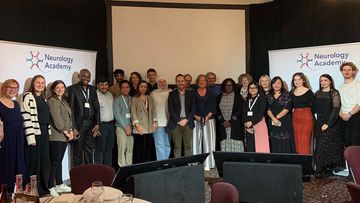Depression and MS: Diagnosing and treating: Anthony Feinstein, MD PhD
Event reportsQuestions answered
- 0:25 – Why is it important to identify and manage depression in PwMS?
- 1:29 – It can be difficult to know if patients are depressed or if some of the symptoms are due to their MS?
- 2:06 – If a patient is low in mood or exhibiting signs that could be depression what can we do?
- 3:23 – How can depression impact the lives of PwMS and their MS symptoms?
- 4:30 – Obviously having a LTC that is unpredictable with uncertain outcomes is likely to impact a patients mood and likelihood of depression but are there other reasons why PwMS are more susceptible to depression? Can MRI scans help us understand why PwMS are more susceptible to depression?
- 6:24 – What are the best ways to treat depression in PwMS?
- 8:21 – Take away message?
Report by Sarah Gibbs, MS Specialist Nurse, Solent NHS Trust
Aims of the session
The aims of this piece are to:
- Recognise how best to detect symptoms of depression in people living with MS (PwMS)
- Discuss the consequences of depression on the lives of PwMS
- Discuss magnetic resonance imaging (MRI) changes associated with depression in PwMS
- Incorporate treatment options available to PwMS who are depressed into their care
Key messages
Symptom management is really important in a disease that cannot be cured. It is important to diagnose depression in PwMS because its impact on MS and its symptoms is significant. Studies have shown that depression is more common in PwMS than in the general population. One-in-two PwMS are likely to experience a clinically significant depression over the lifetime of their disease (Minden, 1990)
It can be difficult to identify whether PwMS are depressed as there are several overlapping symptoms that are common to both depression and MS, such as sleep disturbance and suppressed appetite, fatigue/loss of energy and diminished ability to think/concentrate. While it will be out of an MS nurse’s scope of practice to diagnose depression, there are many self-reporting rating scales that remove these overlapping symptoms, that are quick and easy to use, and are useful in clinical practice if you have concerns about your patient’s mood.
The Beck Depression Inventory-Fast Screen (BDI-FS) (Benedict, 2003) is particularly good for people with medical conditions as it removes the overlapping symptoms such as appetite loss, sleep disturbance, fatigue and concentration. This is also true of the Hospital Anxiety and Depression Scale (HADS) (Zigmond, 1983) and this additionally includes assessment of anxiety, which also has a raised incidence in PwMS.
It is important to diagnose depression because:
- Suicide intent and completion: there is some evidence that PwMS complete more often; one-in-three PwMS will consider suicide at some point in their life
- Quality of life
- Effects on cognition: depression uses up cognitive capacity and slows cognitive processing
- Depression is treatable (although studies have shown that over 50% of PwMS who are diagnosed with depression were not receiving treatment, and those who were received sub-therapeutic doses)
It is important to try and understand the mechanisms whereby PwMS experience depression. There is a growing body of research looking at MRI imaging to determine whether the presence of lesions and brain atrophy can identify pathological changes in depressed people. There may also be an innate vulnerability in PwMS due to a lack of functional connectivity and excessive activation to stimuli.
Structural changes in the brain disturb function and break down connectivity between pivotal regions that play a role in controlling mood – compelling evidence that in some people their depression can be linked to these structural changes. MRI data are clinically important because, in people who cannot identify a reason for their depression (i.e. no specific psychosocial factors), it may be that in some cases the brain changes are the underlying cause of their depression.
Although there are increasingly compelling MRI data, there still needs to be recognition that psychosocial factors are also relevant.
Treating depression has several components:
- Stress management: no benefit is observed with respect to mood, but it has been reported to help with lesion development
- Medications: these come with side effects and this can be a limiting factor
- Cognitive behavioural therapy (CBT): this is the most effective treatment, with no side effects, and can be delivered in groups, by telephone and also self-administered by computer; studies show that all of these can be effective
- Mindfulness training: this has a long-lasting effect, and can also help with fatigue
- Exercise: Many studies have shown that exercise has a positive effect on depression
- Non-invasive brain stimulation therapy: emerging results are positive but this is suitable only for very severe depression which cannot be controlled with any of the above treatments
Conclusion
The take home message from this session was:
The importance of screening MS patients for depression in order not to miss a diagnosis of depression and a potentially treatable disorder is huge, because of the impact of depression on MS and its symptoms.
- There are quick and easy-to-use validated screening measures for depression in PwMS that we can use in clinical practice to identify those where we are concerned that depression may be a factor
- There are effective treatments for depression associated with MS
- CBT is preferable to medication and can be given by telephone or possibly self-administered by computer
References
- Benedict RH, Fishman I, McClellan MM, Bakshi R, Weinstock-Guttman B. Validity of the Beck Depression Inventory-Fast Screen in multiple sclerosis. Mult Scler. 2003;9(4):393-396. doi:10.1191/1352458503ms902oa
- Zigmond AS, Snaith RP. The hospital anxiety and depression scale. Acta Psychiatr Scand. 1983;67(6):361-370. doi:10.1111/j.1600-0447.1983.tb09716.x
- Minden SL, Schiffer RB. Affective disorders in multiple sclerosis: Review and recommendations for clinical research. Arch Neurology 1990; 47(1):98–104.
This activity has been sponsored by Roche Products Limited. Roche Products Limited has had no control over the educational content of this activity.

Related articles
Encouraging excellence, developing leaders, inspiring change
MS Academy was established five years ago and in that time has accomplished a huge amount. The six different levels of specialist MS training are dedicated to case-based learning and practical application of cutting edge research. Home to national programme Raising the Bar and the fantastic workstream content it is producing, this is an exciting Academy to belong to.


